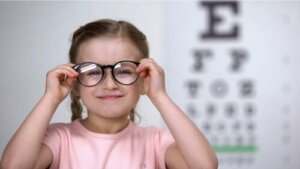How to Detect Astigmatism in Children


Written and verified by the doctor Leonardo Biolatto
Astigmatism in children is a very common vision problem. In fact, it affects almost 15% of the entire general population. Most cases begin in childhood or during adolescence.
This occurs because astigmatism has a certain hereditary component. This information can help guide the diagnosis, since it’s also frequently associated with other visual disturbances, such as myopia, which are inherited.
The problem is that, if astigmatism in children isn’t detected early, it can significantly affect their school performance. Therefore, in this article, we’ll explain everything you need to know about it and how it’s diagnosed.
What’s astigmatism in children?
Astigmatism is a refractive error, just like myopia or farsightedness. Refractive errors are vision alterations that prevent the eye from focusing light accurately on the retina. This results in blurred vision.
In the case of astigmatism, the difficulty occurs when the person tries to focus on an object, no matter how close or far away it is. In other words, it equally affects both far and near vision.
It differs from myopia or near-sightedness because the latter makes distant objects look blurry. For its part, hyperopia or far-sightedness affects near vision. It’s important to know how to distinguish between them because each one requires different corrections.

Keep reading: How to Detect Vision Problems in Young Children
What’s the cause of astigmatism in children?
As we mentioned above, astigmatism in children usually has a hereditary component. In other words, it’s much more common when one or both parents also suffer from it. However, there are cases of no known family history, as the genetic condition isn’t essential.
The corneas of children with astigmatism are flatter than normal. This anterior segment of the eyeball allows light rays to focus on the retina. Its normal shape is concave.
For this reason, when it’s flat, the rays don’t project to the retina but rather in front or behind it. On some occasions, the shape of the lens is also altered, in addition to that of the cornea.
Types of astigmatism
There are different types of astigmatism in children, depending on whether or not it’s associated with other refractive errors. In order to understand it, you first need to know what the meridians of the eye are. If you look at the eye from the front, a meridian divides the eyeball from top to bottom. The other does it from left to right.
Thus, the first type of astigmatism is myopic astigmatism. In this case, one or both of the meridians focus like an eye with near-sightedness. On the other hand, astigmatism in children can also be hyperopic. In this case, the eye poorly focuses on close distances. Finally, astigmatism can be mixed, combining errors of the two previous ones.
The symptoms of astigmatism in children
In order to detect childhood astigmatism, it’s important to pay attention to the symptoms. It’s harder to suspect astigmatism than myopia or hyperopia, as its signs aren’t as obvious and they don’t immediately complicate school performance.
One of the most common symptoms are educational challenges and delays without a known cause. The child may seem inattentive or unfocused, perhaps even hyperactive. However, this lack of concentration stems from the inability to focus on the letters of the books or blackboards.
These children tend to suffer from frequent headaches and tend to squint to try to focus objects. Another typical gesture is that they tilt their head to see better. This leads them to suffer from red eyes or itchiness due to excessive exertion.
In fact, the low interest in reading stems from visual difficulties. When these children read aloud, some tend to skip entire lines of text or switch syllables around.

This article may interest you: Crossed Eyes: Symptoms and Treatments
How to diagnose astigmatism in children
In order to diagnose astigmatism in children, in addition to observing all the symptoms, you need to take your child to an ophthalmologist. The professional will examine their vision with a series of complementary methods and tests to diagnose your child.
In an eye exam, ophthalmologists usually use different lenses to assess all aspects of vision. Once they diagnose the astigmatism, they’ll most likely prescribe your child glasses or contact lenses. However, that must be decided on a case-by-case basis.
What you must remember is that astigmatism in children affects their education. That’s why it’s important to be aware of tell-tale symptoms, such as the way they read or if they suffer from headaches. It’s both parents’ and educators’ responsibility to detect the condition, as they’re the ones who spend the most time with children.
All cited sources were thoroughly reviewed by our team to ensure their quality, reliability, currency, and validity. The bibliography of this article was considered reliable and of academic or scientific accuracy.
- Frecuencia de ametropías en niños. (n.d.). Retrieved June 30, 2020, from http://scielo.sld.cu/scielo.php?script=sci_arttext&pid=S0034-75312010000300004
- Bermúdez, Marta, Yolanda López, and Luisa Fernanda Figueroa. “Astigmatismo en niños.” Ciencia y tecnología para la salud visual y ocular 4.7 (2006): 57-62.
- Características del astigmatismo en niños. (n.d.). Retrieved June 30, 2020, from http://scielo.sld.cu/scielo.php?script=sci_arttext&pid=S0864-21762019000200008
- Lee, Jason, and Daniele P. Saltarelli. “Management of Astigmatism in Children.” Practical Management of Pediatric Ocular Disorders and Strabismus. Springer, New York, NY, 2016. 51-58.
- Zeng, Wen-hui. “Astigmatism on optical quality in young patients with low to moderate myopia.” International Eye Science 18.12 (2018): 2293-2296.
- Liu, Yanlin, et al. “Evaluating internal and ocular residual astigmatism in Chinese myopic children.” Japanese journal of ophthalmology 61.6 (2017): 494-504.
- Shah, Rupal L., et al. “Genome-wide association studies for corneal and refractive astigmatism in UK Biobank demonstrate a shared role for myopia susceptibility loci.” Human genetics 137.11-12 (2018): 881-896.
- Shao, Xu, et al. “Age-Related changes in corneal astigmatism.” Journal of Refractive Surgery 33.10 (2017): 696-703.
- Garg, Pragati, and Astha Agrawal. “Prevalence of astigmatism in headache.” Indian Journal of Clinical and Experimental Ophthalmology 4.2 (2018): 268-272.
- Ijaz, Rida, Hijab Ijaz, and Naeem Rustam. “Prevalence of Astigmatism in School Going Children.” Pakistan Journal of Ophthalmology 33.3 (2017).
This text is provided for informational purposes only and does not replace consultation with a professional. If in doubt, consult your specialist.








